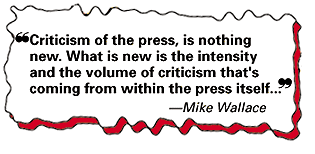 By Melissa Lauber
By Melissa Lauber
Village Life Theme Artist

 By Melissa Lauber
By Melissa Lauber
Village Life Theme Artist
"Life is bad," a man once told the philosopher Voltaire, who simply replied, "Yes? compared to what?"
Many in the U.S. media readily embrace Voltaire's retort as they find themselves under an almost daily barage of curses, complaints and crisis.
According to a 1995, Gallup Public Confidence Poll, only 29 percent of Americans express "a great deal" or "quite a lot" of confidence in newspapers, down from 51 percent in 1979. A Wall Street Journal poll confirmed these findings, with only 21 percent of respondents rating the news media "very" or "mostly honest."
A recent Time/CNN poll found that 75 percent of the respondents agreed that the news media is "too sensationalistic," 63 percent called it "too negative," and 73 percent were "skeptical about the accuracy."
And perhaps most startling, a Times Mirror poll found that 71 percent of Americans believe that "the news media get in the way of society solving its problems."
But the criticism does not stop at the pressroom's doors. On Dec. 4, Mike Wallace, co-editor of "60 Minutes," delivered the Frank E. Gannett lecture at the Media Studies Center in New York. "Criticism of the press, is nothing new," Wallace said. "What is new is the intensity and the volume of criticism that's coming from within the press itself... In our once-romantic profession, the trenchcoat has been replaced by the hairshirt. And its scratch hurts more today."
Wallace cited the recent New York Times headline, "News as the Enemy of Hope," and quoted US News and World Report's comments: "the public these days does not merely dislike the press - it hates the press."
For some people, the continual, daily and detailed coverage of the O.J. Simpson trial in California is one indicator of the problems facing the media. Almost every major U.S. daily has referred to these proceedings, at one time or another, as "a media circus." But they continue to juggle ongoing news reports from the courtroom throughout their pages.
 The Center for People and the Press reports
that fewer than one-quarter of Americans are still interested in the trial
and many editors report being "privately dismayed" that an event of such
"marginal sigificance" receives such comprehensive coverage. It is, they
report, the competition that makes them run the stories.
The Center for People and the Press reports
that fewer than one-quarter of Americans are still interested in the trial
and many editors report being "privately dismayed" that an event of such
"marginal sigificance" receives such comprehensive coverage. It is, they
report, the competition that makes them run the stories.
It is also, said Geneva Overholser, ombudsman for The Washington Post, a matter of pubic interest. "What stories are covered is always a subjective notion," she said.
"But if there's a major trial, it will be covered. While I do not represent the decisons of the Post, I do know that every paper tries to choose their stories based on the importance of the happening and the degree of interest and unusualness. They try to gather a mix of stories that reflects the world around you."
As for only covering the bad news, Overholser said, "news is often defined by what is unusual. Happily enough, the bad, in our society, is still unusual."
For Frances Moore Lappe, editor-in-chief of the American News Service, all the findings about how people view the media simply mean "that for most people, it's easier to kill the messenger- the bearer of bad news - than it is to actually confront the bad news itself.
"When people tell me they don't read the paper any more because it's filled with bad news, I say, 'fine, that's your choice. Just don't blame journalists. Blame life in this messed up society - blame reality.'"
Although they insist that, by its nature, breaking news is often shocking and bad, and must be covered because of its impact on people's lives, both Overholser and Lappe also believe that the media must begin to rethink the way that news is gathered.
Rather than focusing on reporting "from the top down," the press must "widen its lense" to recognize that the most important newsmakers are not always the best sources. Often, change that occurs on grass roots level, must also be covered with integrity in the press, they said.
Copyright © 1998 Villagelife.org Inc. All Rights Reserved